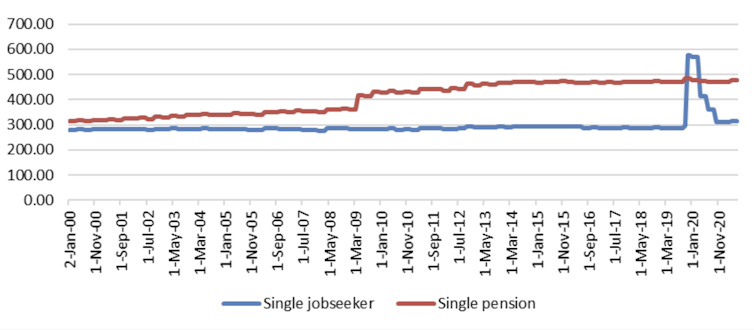
Federal Treasurer Jim Chalmers and Minister for Social Services Amanda Rishworth established an Economic Inclusion Advisory Committee in December 2022 to advise the government on ways to lift economic inclusion and reduce disadvantage.
I am a member of that committee, which was tasked with reporting to the government at least two weeks prior to the federal budget in May – enough time to include a response to in the budget.
The committee delivered its report to the government in late February. The goverment made it public yesterday.
There are 37 recommendations – too many to discuss in detail here. The most pressing concern, and the most important for immediate policy action, is to substantially increase the JobSeeker payment for the unemployed.
Apart from a temporary boost during the COVID-19 pandemic, the payment (previously known as the NewStart Allowance) has declined relative to median incomes and other welfare payments for several decades.
JobSeeker Payment relative to Age Pension, 2000 to 2021


Interim Economic Inclusion Advisory Committee, 2023–24 Report to the Australian Government
Given the committee only had a couple of months to draft a report, it was not possible to review all aspects of the welfare system – such as the age pension, disability support payments and family payments – or the many other aspects that affect economic inclusion.
Read more:
There are lots of poverty lines, and JobSeeker isn't above any of them
The greatest, most urgent, need
Nonetheless our judgement is the evidence shows the most urgent need of policy attention is the precarious financial situation for almost 1 million Australians that depend on JobSeeker and associated payments such as a Youth Allowance
The 4 million Australians receiving other payments (age pension, disability pension, veterans pension, parenting payments and carer payments) are more likely to be matching up to adequacy benchmarks. There was a substantial boost to most pension payments following the 2009 Harmer Pension Review.
The committee also found Rent Assistance is inadequate and not keeping up with rental costs for most low-income households. It too requires an urgent and substantial increase.
But the highest priority is JobSeeker, as the most effective payment to lower financial stress and poverty. JobSeeker has a larger budget and is better targeted than Rent Assistance to those in most financial need.
What will it cost?
Increasing JobSeeker and associated working age payments would cost the federal budget about $5.7 billion in 2023, according to Australian National University’s PolicyMod model of Australia’s tax and transfer system. Over the four years of forward estimates (2023 to 2026), the cost would be about $24 billion.
The total cost of welfare payments in 2023-24 is expected to reach A$145 billion. So $5.7 billion, while a substantial additional expense, does only represent a 4% increase in the welfare cash payments, and less than 1% of the total federal budget.
The available evidence outlined in the report suggests the recommended increase would be unlikely to greatly impact participation, given the payment would still be substantially lower than the minimum wage. Indeed the committee’s judgement was that leaving it at the current rate may be a net negative for participation, with poverty being a barrier to employment.
Read more:
Australia's 'underclass' don't like work? Our research shows vulnerable job seekers don't get the help they need
The welfare system in Australia is supposed to provide an adequate safety net but for nearly a million Australians the system is not achieving this vital goal.
The government has an opportunity in the next budget to right a significant wrong for a group of some of the most disadvantaged people in a mostly otherwise wealthy nation.
Authors: Ben Phillips, Associate Professor, Centre for Social Research and Methods, Director, Centre for Economic Policy Research (CEPR), Australian National UniversityRead more






